
Question Number 149485 by abdurehime last updated on 05/Aug/21
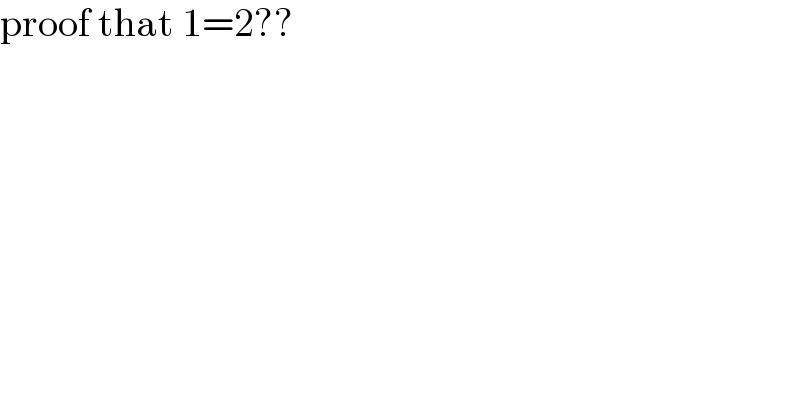
$$\mathrm{proof}\:\mathrm{that}\:\mathrm{1}=\mathrm{2}?? \\ $$
Answered by Olaf_Thorendsen last updated on 05/Aug/21
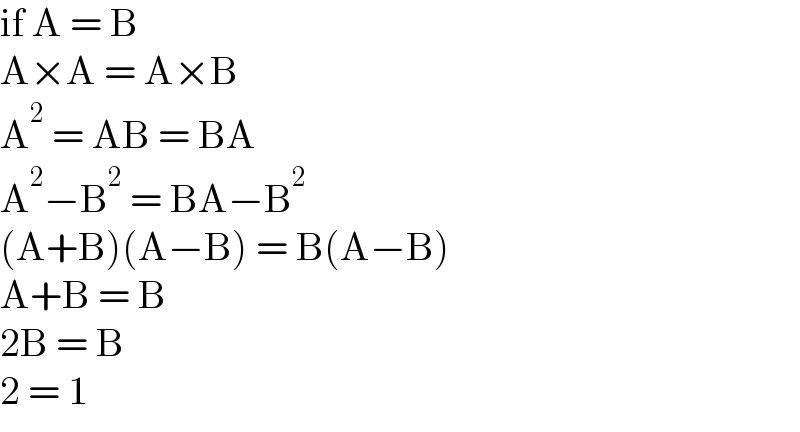
$$\mathrm{if}\:\mathrm{A}\:=\:\mathrm{B} \\ $$$$\mathrm{A}×\mathrm{A}\:=\:\mathrm{A}×\mathrm{B} \\ $$$$\mathrm{A}^{\mathrm{2}} \:=\:\mathrm{AB}\:=\:\mathrm{BA} \\ $$$$\mathrm{A}^{\mathrm{2}} −\mathrm{B}^{\mathrm{2}} \:=\:\mathrm{BA}−\mathrm{B}^{\mathrm{2}} \\ $$$$\left(\mathrm{A}+\mathrm{B}\right)\left(\mathrm{A}−\mathrm{B}\right)\:=\:\mathrm{B}\left(\mathrm{A}−\mathrm{B}\right) \\ $$$$\mathrm{A}+\mathrm{B}\:=\:\mathrm{B} \\ $$$$\mathrm{2B}\:=\:\mathrm{B} \\ $$$$\mathrm{2}\:=\:\mathrm{1} \\ $$
Commented by cherokeesay last updated on 05/Aug/21

$$ \\ $$$$\mathrm{you}\:\mathrm{can}\:\mathrm{only}\:\mathrm{simplify}\:\mathrm{A}−\mathrm{B}\:\mathrm{on}\:{both}\:{sides}\:{of}\:{the}\:{equality}\:\left(\mathrm{5}{th}\:{line}\right)\:{when}\:{A}\neq{B}\:! \\ $$$${but}\:{A}\:=\:{B}\:\Rightarrow\:{A}\:−\:{B}\:=\:\mathrm{0}\:!!! \\ $$$${so}\:{you}\:{will}\:{have}\:\mathrm{0}\:{of}\:{the}\:{sides}\:{of}\:{this}\:{equality}\:! \\ $$
Commented by peter frank last updated on 05/Aug/21

$${A}+{B}={B} \\ $$$${A}=\mathrm{0}\: \\ $$
Commented by Olaf_Thorendsen last updated on 05/Aug/21

$$\mathrm{Of}\:\mathrm{course}\:\mathrm{sir}\:! \\ $$$$\mathrm{But}\:\mathrm{in}\:\mathrm{the}\:\mathrm{real}\:\mathrm{life}\:\mathrm{1}\:\neq\:\mathrm{2}\:\mathrm{too}. \\ $$
Commented by MJS_new last updated on 06/Aug/21

$$\mathrm{I}\:\mathrm{remember}\:\mathrm{someone}\:\mathrm{here}\:\mathrm{proved} \\ $$$$\mathrm{i}=\sqrt{−\mathrm{1}}=\pm\mathrm{1} \\ $$$$\mathrm{but}\:\mathrm{I}\:\mathrm{don}'\mathrm{t}\:\mathrm{remember}\:\mathrm{how}...\:\mathrm{that}\:\mathrm{guy}\:\mathrm{was} \\ $$$$\mathrm{seriously}\:\mathrm{convinced}...\:\mathrm{as}\:\mathrm{I}\:\mathrm{stated}\:\mathrm{before}: \\ $$$${those}\:{who}\:{know}\:{nothing}\:{must}\:{believe}\:{everything} \\ $$
Commented by MJS_new last updated on 06/Aug/21
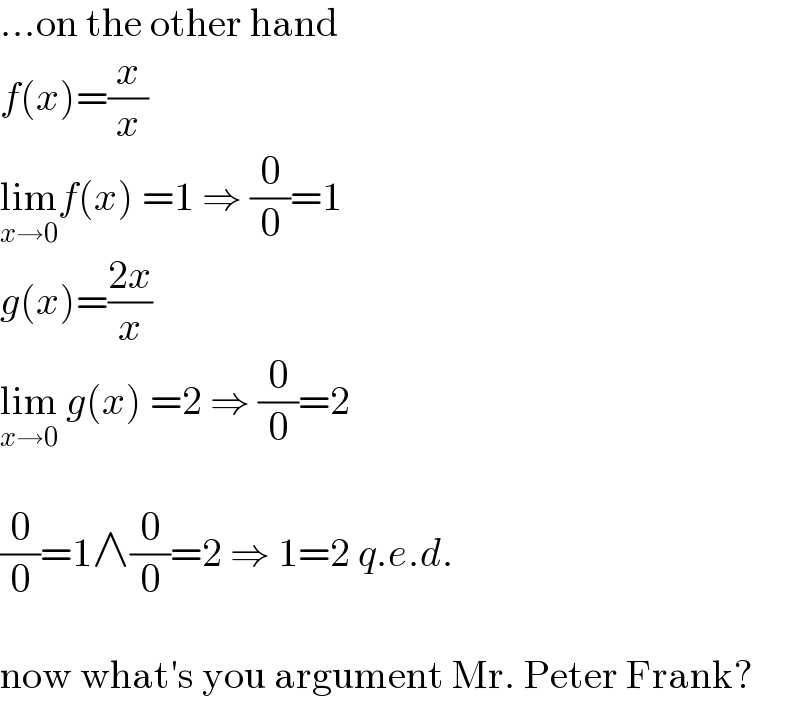
$$...\mathrm{on}\:\mathrm{the}\:\mathrm{other}\:\mathrm{hand} \\ $$$${f}\left({x}\right)=\frac{{x}}{{x}} \\ $$$$\underset{{x}\rightarrow\mathrm{0}} {\mathrm{lim}}{f}\left({x}\right)\:=\mathrm{1}\:\Rightarrow\:\frac{\mathrm{0}}{\mathrm{0}}=\mathrm{1} \\ $$$${g}\left({x}\right)=\frac{\mathrm{2}{x}}{{x}} \\ $$$$\underset{{x}\rightarrow\mathrm{0}} {\mathrm{lim}}\:{g}\left({x}\right)\:=\mathrm{2}\:\Rightarrow\:\frac{\mathrm{0}}{\mathrm{0}}=\mathrm{2} \\ $$$$ \\ $$$$\frac{\mathrm{0}}{\mathrm{0}}=\mathrm{1}\wedge\frac{\mathrm{0}}{\mathrm{0}}=\mathrm{2}\:\Rightarrow\:\mathrm{1}=\mathrm{2}\:{q}.{e}.{d}. \\ $$$$ \\ $$$$\mathrm{now}\:\mathrm{what}'\mathrm{s}\:\mathrm{you}\:\mathrm{argument}\:\mathrm{Mr}.\:\mathrm{Peter}\:\mathrm{Frank}? \\ $$
Commented by MJS_new last updated on 06/Aug/21
��������
Commented by iloveisrael last updated on 06/Aug/21
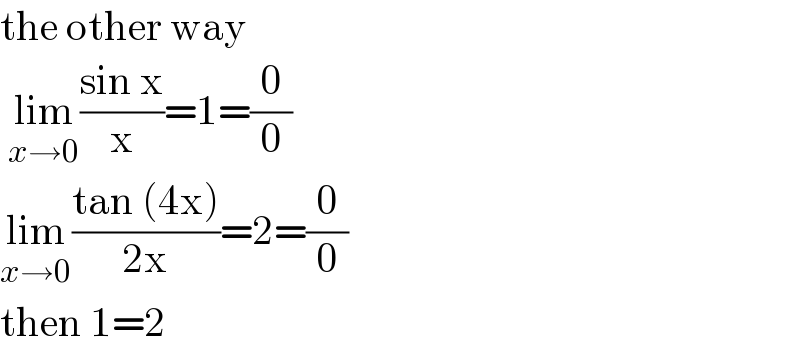
$$\mathrm{the}\:\mathrm{other}\:\mathrm{way}\: \\ $$$$\:\underset{{x}\rightarrow\mathrm{0}} {\mathrm{lim}}\frac{\mathrm{sin}\:\mathrm{x}}{\mathrm{x}}=\mathrm{1}=\frac{\mathrm{0}}{\mathrm{0}} \\ $$$$\underset{{x}\rightarrow\mathrm{0}} {\mathrm{lim}}\frac{\mathrm{tan}\:\left(\mathrm{4x}\right)}{\mathrm{2x}}=\mathrm{2}=\frac{\mathrm{0}}{\mathrm{0}} \\ $$$$\mathrm{then}\:\mathrm{1}=\mathrm{2}\: \\ $$
Commented by Olaf_Thorendsen last updated on 06/Aug/21
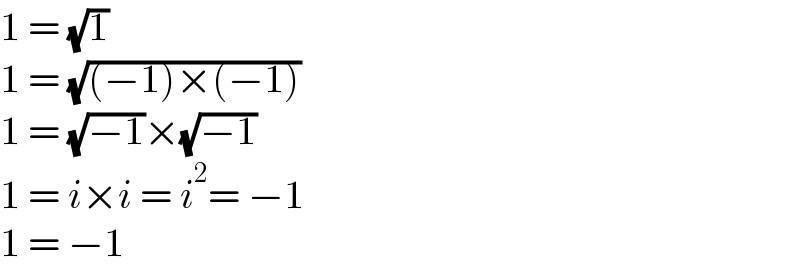
$$\mathrm{1}\:=\:\sqrt{\mathrm{1}} \\ $$$$\mathrm{1}\:=\:\sqrt{\left(−\mathrm{1}\right)×\left(−\mathrm{1}\right)} \\ $$$$\mathrm{1}\:=\:\sqrt{−\mathrm{1}}×\sqrt{−\mathrm{1}} \\ $$$$\mathrm{1}\:=\:{i}×{i}\:=\:{i}^{\mathrm{2}} =\:−\mathrm{1} \\ $$$$\mathrm{1}\:=\:−\mathrm{1} \\ $$
Commented by mathmax by abdo last updated on 06/Aug/21

$$\mathrm{but}\:\mathrm{its}\:\mathrm{correct}\:\mathrm{dans}\:\mathrm{Z}/\mathrm{2Z} \\ $$
Commented by MJS_new last updated on 06/Aug/21
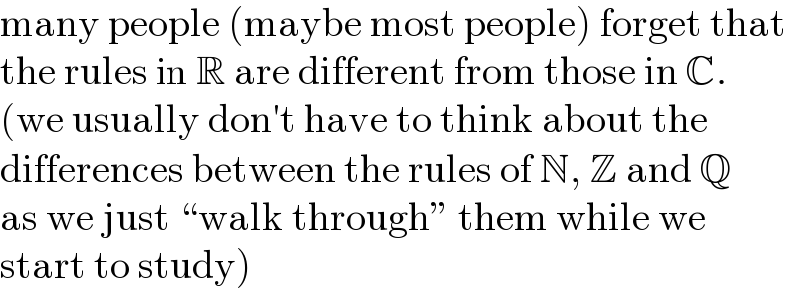
$$\mathrm{many}\:\mathrm{people}\:\left(\mathrm{maybe}\:\mathrm{most}\:\mathrm{people}\right)\:\mathrm{forget}\:\mathrm{that} \\ $$$$\mathrm{the}\:\mathrm{rules}\:\mathrm{in}\:\mathbb{R}\:\mathrm{are}\:\mathrm{different}\:\mathrm{from}\:\mathrm{those}\:\mathrm{in}\:\mathbb{C}. \\ $$$$\left(\mathrm{we}\:\mathrm{usually}\:\mathrm{don}'\mathrm{t}\:\mathrm{have}\:\mathrm{to}\:\mathrm{think}\:\mathrm{about}\:\mathrm{the}\right. \\ $$$$\mathrm{differences}\:\mathrm{between}\:\mathrm{the}\:\mathrm{rules}\:\mathrm{of}\:\mathbb{N},\:\mathbb{Z}\:\mathrm{and}\:\mathbb{Q} \\ $$$$\mathrm{as}\:\mathrm{we}\:\mathrm{just}\:``\mathrm{walk}\:\mathrm{through}''\:\mathrm{them}\:\mathrm{while}\:\mathrm{we} \\ $$$$\left.\mathrm{start}\:\mathrm{to}\:\mathrm{study}\right) \\ $$
Commented by ajfour last updated on 06/Aug/21

$$\mathrm{2}^{{nd}} \:{step}\:{to}\:\mathrm{3}^{{rd}} \:\:{step}\:{is}\:{not} \\ $$$${allowed},\:{there}\:{are}\:{certain} \\ $$$${rules}\:{here}\:{that}\:{need}\:{be} \\ $$$${followed}.. \\ $$
Commented by peter frank last updated on 06/Aug/21

$${no}\:{argument}\:{sir}.{understood} \\ $$
Answered by puissant last updated on 06/Aug/21
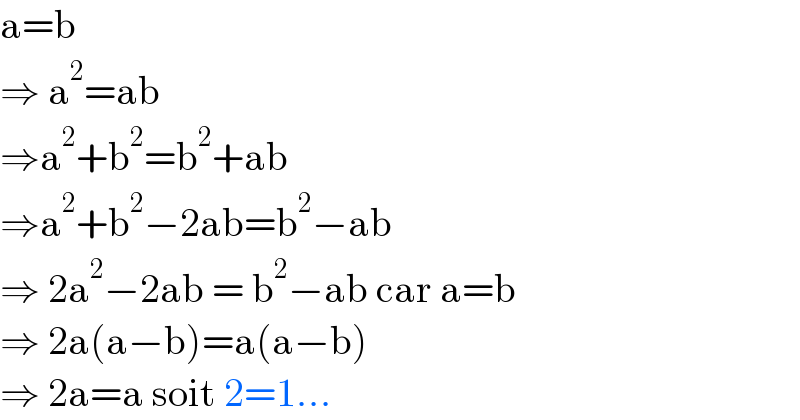
$$\mathrm{a}=\mathrm{b} \\ $$$$\Rightarrow\:\mathrm{a}^{\mathrm{2}} =\mathrm{ab} \\ $$$$\Rightarrow\mathrm{a}^{\mathrm{2}} +\mathrm{b}^{\mathrm{2}} =\mathrm{b}^{\mathrm{2}} +\mathrm{ab} \\ $$$$\Rightarrow\mathrm{a}^{\mathrm{2}} +\mathrm{b}^{\mathrm{2}} −\mathrm{2ab}=\mathrm{b}^{\mathrm{2}} −\mathrm{ab} \\ $$$$\Rightarrow\:\mathrm{2a}^{\mathrm{2}} −\mathrm{2ab}\:=\:\mathrm{b}^{\mathrm{2}} −\mathrm{ab}\:\mathrm{car}\:\mathrm{a}=\mathrm{b} \\ $$$$\Rightarrow\:\mathrm{2a}\left(\mathrm{a}−\mathrm{b}\right)=\mathrm{a}\left(\mathrm{a}−\mathrm{b}\right) \\ $$$$\Rightarrow\:\mathrm{2a}=\mathrm{a}\:\mathrm{soit}\:\mathrm{2}=\mathrm{1}... \\ $$
